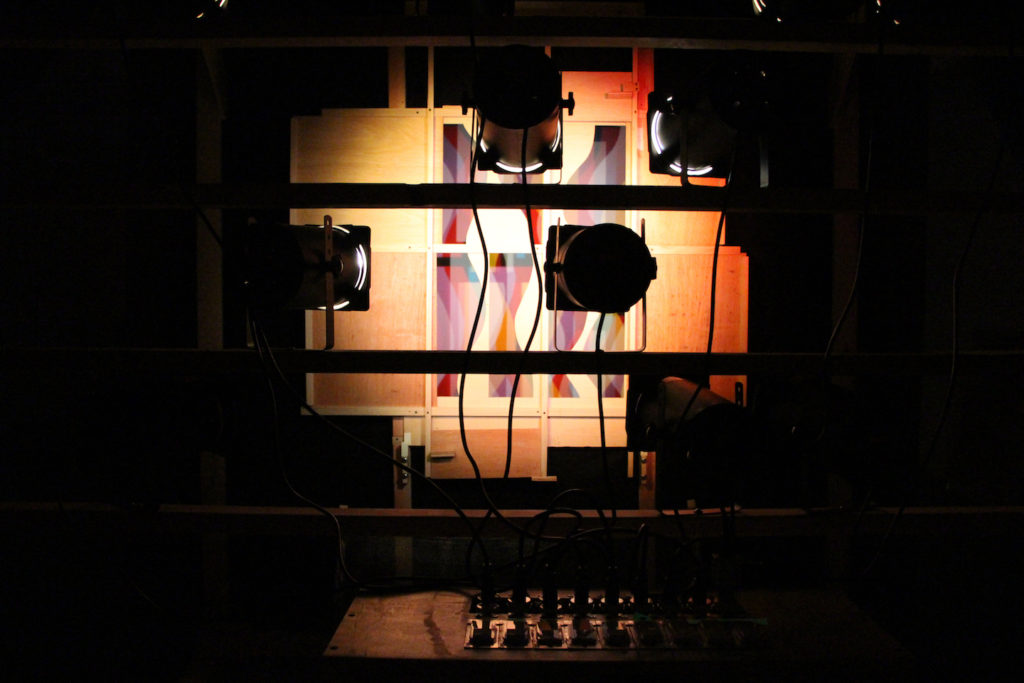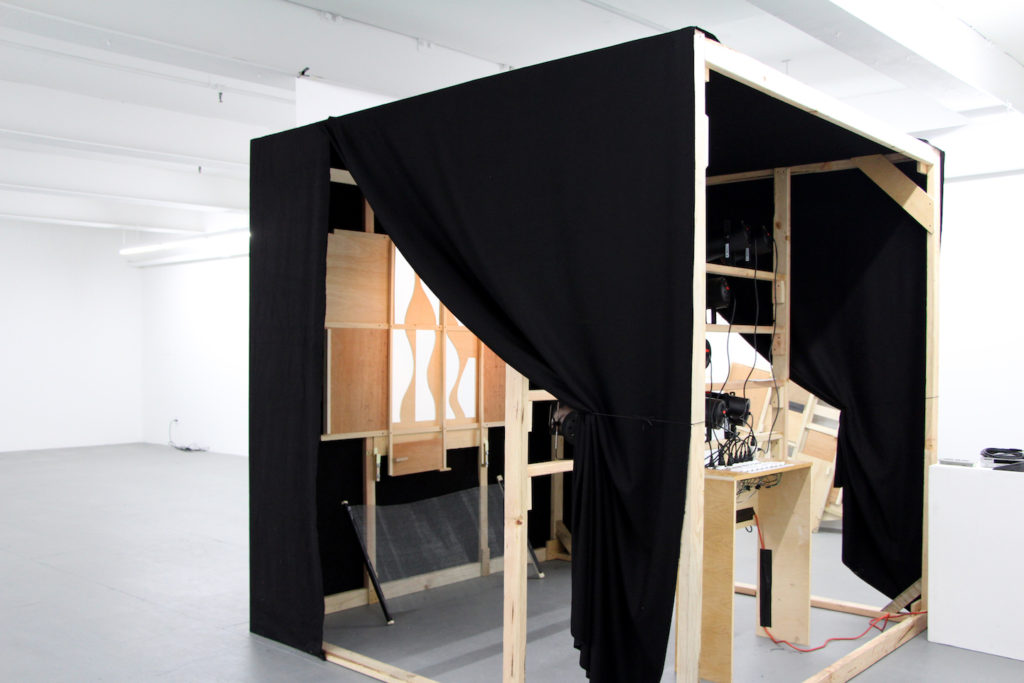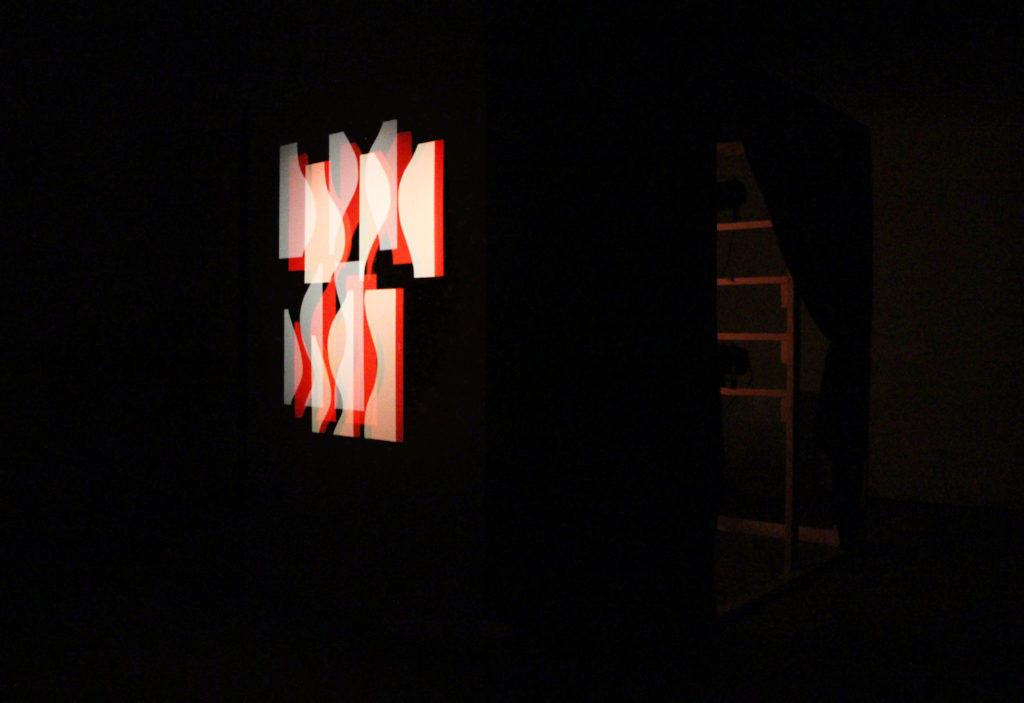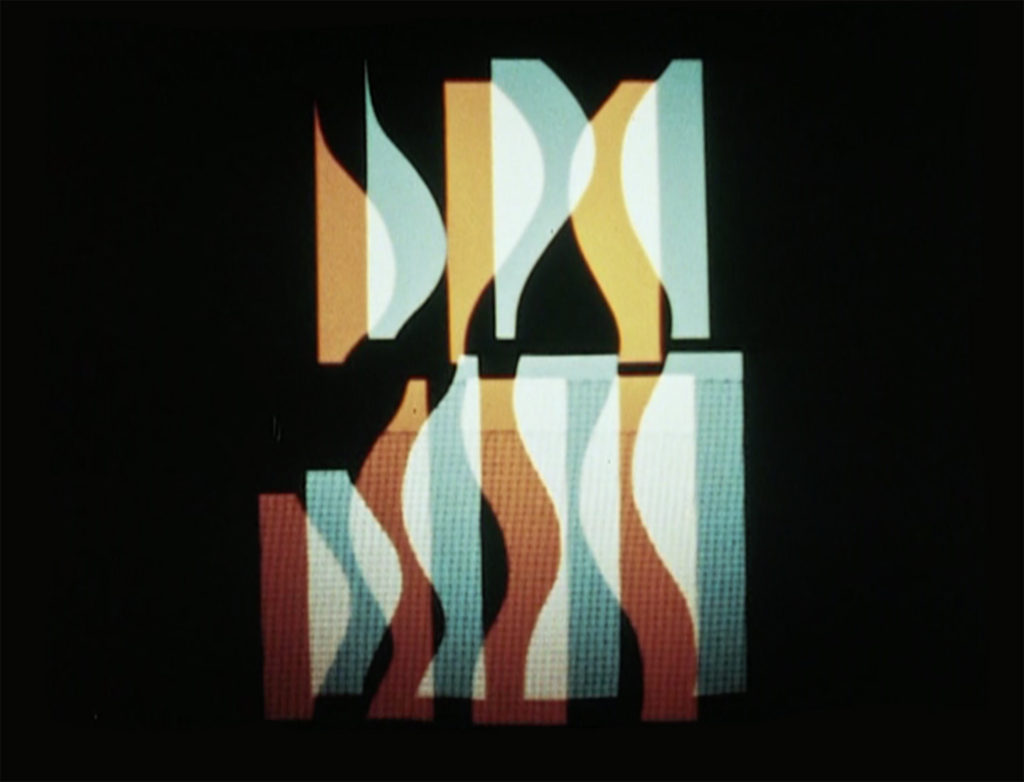Kurt Schwerdtfeger
Reflektorische Farblichtspiele (Reflecting Color-Light-Play)
January 31 – March 22, 2020 (extended)
Opening Friday January 31, 6-9pm

Installation Views
Recent Press:
“Kurt Schwerdtfeger”, by Martha Schwendener, The New York Times
“Kurt Schwerdtfeger”, by Yuki Higashino, Critics’ Pick, Artforum
Microscope is very pleased to present an exhibition focused on German artist Kurt Schwerdtfeger’s “Reflektorische Farblichtspiele” (Reflecting Color-Light-Play), which was first presented in 1922 at the home of Vasily Kandinsky as part of a Lantern Festival, when the then 25-year-old artist was a student at the Bauhaus in Weimar. The piece — which in recent years has received wider recognition as a groundbreaking work of the Bauhaus movement and of 20th century film and sculpture — utilizes a large, hand-built cube projection apparatus in which performers, who are unseen by the audience, activate panels of cut-out shapes and a switchboard of colored lights to form a complex, abstract light play, composed of several movements, appearing on its screen surface.
“While conceptualizing a shadow play titled “Days of Genesis” for a Lantern Festival it seemed necessary to use not only shadow figures but color shapes on black as well. At that very moment I perceived the idea of color-light plays in abstract form with free-moving, superimposed shapes of colored light moving in time.” – Kurt Schwerdtfeger, 1962
The exhibition marks the first time the work has been on exhibition in the US and coincides with the return of the work to the US after a year of exhibitions at Haus Der Kulturen Der Welt (HKW) in Berlin, Germany and at Zentrum Paul Klee in Bern, Switzerland as part of the international exhibition “bauhaus imaginista,” curated by Marion Von Osten and Grant Watson in celebration of the 100th anniversary of the Bauhaus.
The current apparatus was reconstructed by the gallery in collaboration with artist Daniel Wapner in 2016 for the first re-staging of the work in 50 years in “Dreamlands: Expanded,” a series of live expanded cinema performances presented at the gallery as part of the Whitney Museum’s exhibition “Dreamlands: Immersive Cinema & Art, 1905-2016,” during which it was performed once and only briefly on view for the audience in attendance that night.
The apparatus, its light-activating keyboard and five stenciled panels — which are manipulated live to create the visuals for the five Sätze, “sets” or movements of the piece — and the soundtracks used in the live performances are based on film documentation and a recording of the last presentation of the work that took place under the oversight of the artist, who unexpectedly died just weeks before that performance in 1966. The reconstruction and re-staging are also in accordance with original notes and documentation of the work dating back to the 1920s provided by the Kurt Schwerdtfeger Estate.
Video documents of the 1966 performance, as well as of the 2016 and 2019 re-stagings will also be on view for the exhibition, along with additional and previously unseen historical documents.
Although no recordings exist of the original performance of the work in 1922, photographic documents from that performance appear in the first Bauhaus catalog of 1919 to 1922; in MoMA’s 1938/39 exhibit “Bauhaus 1919-1928”; as well as in the more recent “Bauhaus 1919–1933: Workshops for Modernity”, 2009/10.
Please note: Among the live performances of “Reflektorische Farblichtspiele” and other events that will take place over the course of the exhibition are a brief demonstration during the opening on January 31st, and a live performance on Monday February 17th by New York artists Lary 7, on the keyboard-like light system; Bradley Eros and Joel Schlemowitz manipulating the stenciled shapes; and Rachael Guma on sound and offering additional visual support. More details about these and other performances as well as a panel TBA soon.
“Reflektorische Farblichtspiele” (Reflecting Color-Light-Play) opens Friday January 31st and continues through March 15th (extended from March 8th). Opening Reception: Friday January 31, 6-9pm, with mini-performance at 6:30pm.
Live Performance: Monday February 17, 7:30pm.
Live Performance: Sunday March 8, 7:30pm.
Panel discussion TBA.
For inquires or high res images please contact the gallery at inquiries@microscopegallery.com or by phone at 347.925.1533.
_
Kurt Schwerdtfeger was born in 1897 in the German city of Puddiger (now Podgórki, Poland). Schwerdtfeger in 1919 moved first to Königsberg, then Jena to pursue studies in art history and philosophy. In 1920, he joined the newly founded Bauhaus in Weimar as a sculptor and studied under Oskar Schlemmer and Johannes Itten. Schwerdtfeger focused on his own work, while at the same time contributing commissioned works to festivals and exhibitions, in the context of which his “Reflecting Color-Light-Play” (Reflektorische Farblichtspiele) came to life and was first performed in the apartment of Wassily Kandinsky in 1922.
As a representative of the students, he participated in meetings and intervened in the planning and implementation of the Bauhaus Week. In 1924, Schwerdtfeger left the Bauhaus in protest of his work being appropriated by a fellow student. Schwerdtfeger began working at the newly founded Kunstgewerbeschule Stettin in 1925 and became head of the sculpture department at the Stettin School of Applied Arts two years later. In that period Schwerdtfeger exhibited his work among others in the Galerie Der Sturm in Berlin, alongside works by artists from the group “Berlin Secession” as well as the French “UAM” (Union des artistes moderne).
At the time he also became a member of the Novembergruppe (November Group), the Werkbund (a German association of artists, architects, designers, and industrialists established in 1907) and later of the artist federation Künstlerbundes Neues Pommern (New Artists Association of Pomerania). In 1937, he was dismissed as teacher and his artworks in museum collections were branded as “degenerate art” and removed by the Nazis. Nevertheless, he set up a studio in Stettin and continued to work as an artist.
In 1946, Schwerdtfeger was appointed professor at the Alfeld College of Education, in Alfeld, Germany and was in contact with Paul Citroen, Walter Gropius, Gregor Rosenbauer and Lothar Schreyer, among others. Schwerdtfeger reconstructed “Reflektorisches Farblichtspiele“ with his students between 1964 and 1966 for a performance at the Kunstverein Hannover that took place just a few weeks after his death on August 8, 1966.
Schwerdtfeger’s work appeared in the exhibitions “Bauhaus: 1919-1928” at the Museum of Modern Art (MoMA) in 1938/39; in “50 jahre bauhaus” at Wuertembergischer Kunstverein, Stuttgart, Germany in 1968, which then traveled to Amsterdam, Paris, New York and Tokyo, among others. In Alfeld, an assembly hall has been named after him, and his sculpture “Saint Francis” is publicly displayed. Schwerdtfeger’s work is in public collections in Berlin and Stettin as well as in the Museum of Modern Art (MoMA), New York; Harvard Art Museums, Cambridge, MA, among others.




